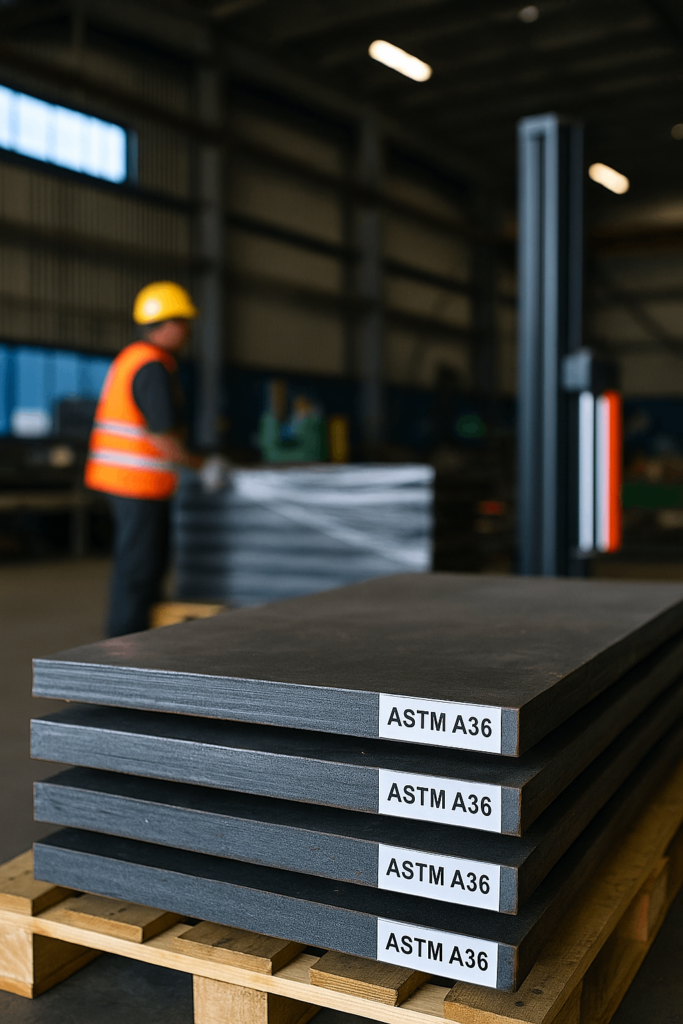Introduction: The Real Meaning Behind ASTM Compliance
In international B2B sourcing, material quality is only part of the equation. For professional buyers managing large-scale metal procurement, the real focus lies in supplier reliability, documentation traceability, and risk mitigation. That’s where ASTM standards come into play.
ASTM—known formally as ASTM International—sets globally accepted material and product standards. These benchmarks allow overseas purchasers to verify consistency, regardless of location. For buyers evaluating suppliers across borders, ASTM compliance is not just about material conformity; it signals discipline, control, and the supplier’s understanding of global procurement expectations.
This guide is crafted for international metal product buyers who need more than definitions. You’ll get direct insights into how ASTM compliance affects sourcing strategy, how to validate supplier capability, and what documents and practices you should expect throughout the buying process.
1. What Does ASTM Mean and Why It Matters in Sourcing
ASTM stands for the American Society for Testing and Materials. It is now officially known as ASTM International and is one of the world’s leading standards organizations. It develops voluntary technical standards for a wide range of industries—particularly construction materials, metals, plastics, and consumer products.
For metal buyers, ASTM standards offer a shared language with suppliers. They define not only physical characteristics of steel and aluminum but also the required test methods, tolerances, and certification expectations. In short, what are ASTM standards? They are your quality insurance in an uncertain global supply environment.
Unlike local specifications that vary by country, ASTM standards are widely referenced in international construction codes and procurement contracts. If you’re buying steel pipe for the Middle East or sheet metal for the U.S. market, specifying ASTM standards such as A36 or A500 gives you legal and technical leverage. It minimizes delivery issues and builds trust with clients downstream.
What Is an ASTM Material?
An ASTM material refers to any material—such as steel, aluminum, or copper—that conforms to a technical specification set by ASTM International. These standards define the material’s chemical composition, mechanical strength, manufacturing process, and testing requirements.
ASTM organizes materials using codes like:
| ASTM Code | Material Type | Description |
|---|---|---|
| A36 | Carbon Steel Plate | General structural steel |
| A500 | Cold-Formed Tubing | For load-bearing structures |
| B221 | Aluminum Extrusion | For industrial & building components |
| A123 | Zinc-Coated Steel | Corrosion-resistant applications |
The letter prefix indicates material family:
A = ferrous metals
B = non-ferrous metals
D/E/F… = vary by product type
At YISHANG, we fabricate using ASTM-compliant materials including stainless steel, galvanized low-carbon steel, aluminum, and more—backed by full testing and documentation.
Understanding ASTM materials helps buyers align technical expectations with supplier capabilities, reducing sourcing risk.
2. Understanding ASTM Standards and Material Classifications
ASTM standards aren’t arbitrary. Each follows a detailed format so that engineers, QA teams, and buyers can apply them consistently.
The most common categories you will see are:
Specification (e.g., ASTM A36): Defines chemical and mechanical properties
Test Method (e.g., ASTM E8): Describes how to test those properties
Practice: Recommends steps without mandatory outcomes
Guide: Offers industry-recognized best practices
A single ASTM document typically includes:
Scope of the standard
Referenced standards (sometimes including ISO or EN equivalencies)
Terminology
Requirements for dimensions, chemical composition, strength, and appearance
Prescribed test methods
Consider ASTM A500. Instead of simply stating it’s for cold-formed carbon steel tubing, it specifies minimum yield strengths (345 MPa for Grade C), wall thickness tolerances, and permissible elements. This level of detail ensures all tubing sourced under A500 performs as expected—particularly important in load-bearing infrastructure.
For buyers asking “astm what is” or “what is astm standard in purchasing context,” it’s this: a tool to ensure identical expectations between buyer and supplier.
3. Why ASTM Compliance Influences International Procurement
Clear Communication = Fewer Errors
When sourcing overseas, miscommunication can result in delays or defective batches. An order stating “ASTM A36 steel plate, 12mm thickness” provides immediate clarity, while a generic “mild steel” description invites risk. ASTM simplifies supplier evaluation and quotation comparison.
Contractual Strength and Insurance Validity
Projects requiring certified quality—like public infrastructure or commercial HVAC systems—often reference ASTM standards directly in contracts. Insurance coverage and performance warranties may depend on ASTM-based documentation.
For example, a buyer sourcing steel tubing for U.S. commercial buildings must ensure ASTM A500 Grade C compliance. Deviations can result in site rejections or safety liabilities.
Easier Quality Audits
Factories claiming ASTM-compliant output must maintain traceability: raw material test reports (MTRs), certificates of conformance (CoC), and standard-aligned process controls. Buyers auditing suppliers can request these as a benchmark.
For high-volume buyers, ASTM compliance is a screening filter. Suppliers with ASTM-ready production processes signal readiness for international business.
4. ASTM Standards in Steel and Fabricated Metal Applications
If you’re sourcing fabricated metal parts or raw materials, the following ASTM standards are often requested:
| ASTM Standard | Material Type | Common Applications |
|---|---|---|
| A36 | Carbon Structural Steel | Beams, frames, anchors |
| A53 | Welded & Seamless Steel Pipe | Plumbing, HVAC, mechanical systems |
| A500 | Cold-formed Tubing | Structural columns, racks, general framing |
| A123 | Zinc Coatings (Galvanizing) | Outdoor parts, fencing, power infrastructure |
Let’s take ASTM A36 again. It defines low-carbon steel with a minimum yield of 250 MPa. Its workability makes it ideal for OEM fabricators. Buyers should request supporting MTRs showing tensile and elongation results per ASTM A370 test methods.
ASTM A123 is also worth noting. For outdoor structural steel, ASTM A123 guarantees zinc coating thickness, adhesion, and corrosion protection. International buyers sourcing hot-dip galvanized steel must request post-treatment verification according to this standard.
If you’re wondering “what is the astm standard buyers should prioritize,” these are your top candidates.

5. How to Validate ASTM Compliance as a Buyer
Even if a supplier claims ASTM-grade production, it’s up to you to verify. Here’s how professional buyers validate compliance:
Step 1: Request a Material Test Report (MTR)
An MTR confirms mechanical and chemical properties of the steel used, matched against ASTM specifications. It includes batch number, test results, and certifying personnel.

Step 2: Ask for Certificates of Conformance (CoC)
A CoC is the supplier’s formal declaration that products meet the listed ASTM standard.
Step 3: Third-party Lab Testing (When Required)
For critical components or large contracts, consider asking the supplier to submit samples to an ISO 17025-accredited lab (e.g., SGS or TÜV) for independent testing. YISHANG frequently supports this process upon buyer request.

Step 4: Evaluate Internal Controls
ASTM compliance isn’t just about documents. A qualified factory must:
Follow standard-based process control (welding, machining, surface treatment)
Maintain calibrated testing equipment
Train staff on ASTM-referenced SOPs
At YISHANG, we integrate ASTM into our production—from raw material selection to final QA documentation. Buyers receive complete paperwork, including MTRs, CoCs, and dimensional checks, with each shipment.
6. Supplier Transparency: Why It Matters in Volume Orders
When buying at scale, your risk compounds. A supplier delivering 1,000 non-compliant brackets can halt a project. This is why transparency matters.
At YISHANG, each ASTM-based order follows a documented flow:
Pre-approved raw materials (ASTM-referenced mill certs)
In-process inspections and photo documentation
Pre-shipment quality files aligned with buyer standards
Case in point: we recently fulfilled a Texas-based client’s order for 12,000 ASTM A36 brackets. The components passed third-party mechanical testing and were shipped 10 days early.
Buyers often ask if we can meet specific ASTM grades, such as A500 Grade B or C. The answer is yes—we can follow buyer-assigned versions, and work with SGS or local labs when needed.
7. ASTM Beyond Metals: Trends Buyers Should Watch
ASTM isn’t limited to steel. Emerging procurement trends include:
ASTM F42: Additive manufacturing standards (for 3D printed parts)
ASTM D7611: Material classification in recycled plastics
Digital Integration: Machine-readable ASTM specifications for ERP traceability
For buyers with ESG goals, ASTM is now developing green manufacturing standards and recycled content criteria. YISHANG is aligning with these to help clients meet sustainability goals.
Conclusion: ASTM = Fewer Surprises, More Confidence
For international buyers, ASTM isn’t paperwork—it’s protection. It protects against wrong materials, mismatched tolerances, and unverified performance.
Sourcing ASTM-compliant parts means faster project approval, better documentation for customs, and reduced defect risk. It signals to your clients that you buy right, not just cheap.
Need ASTM-compliant metal parts for your project? Contact YISHANG to get a quote and documentation sample today.
Frequently Asked Questions
What does ASTM mean in international sourcing?
ASTM stands for the American Society for Testing and Materials. In global sourcing, ASTM standards help buyers verify the quality, strength, and consistency of metal materials regardless of where the product is manufactured.
Why are ASTM standards important for metal product buyers?
ASTM standards offer clarity in material specifications, reduce the risk of non-compliant shipments, and ensure suppliers meet consistent global benchmarks—essential for large-scale or critical-use metal procurement.
What is the difference between ASTM A36 and ASTM A500?
ASTM A36 is a structural steel standard for plates and bars with excellent weldability, while ASTM A500 covers cold-formed structural tubing with stricter tolerances and higher strength. The choice depends on your structural design and load requirements.
Can I request third-party lab testing for ASTM compliance?
Yes. Many international buyers request third-party testing through ISO/IEC 17025-certified labs like SGS or TÜV. At YISHANG, we can coordinate this process based on your project needs.
What documents should I ask from suppliers to verify ASTM compliance?
You should request a Material Test Report (MTR), a Certificate of Conformance (CoC), and, if necessary, a third-party lab test report confirming mechanical and chemical properties as defined by the specific ASTM standard.
Does YISHANG support custom ASTM grades?
Yes. YISHANG supports ASTM A36, A500 Grade B/C, A123 and others. We follow buyer-specified versions and can align fabrication, documentation, and inspection with your project standards.
What is an ASTM Material?
An ASTM material is a type of raw or processed material—such as steel, aluminum, or copper—that complies with an ASTM specification. These specs define the material’s required performance, dimensions, and chemical properties. Choosing ASTM materials helps ensure consistent quality across global suppliers.
